

Ghars Well is one of the wells of al-Madinah al-Munawwarah, also known as al-Aghras Well. It was named after the Arabic word "Ghars," which refers to planting palms and trees. The well is located in Qurban area, east of Quba Mosque, near the intersection of al-Hijra Road and Ali Bin Abi Talib Street, approximately 1,500 m from Quba Mosque.
History of Ghars Well
Ghars Well is one of the significant wells in al-Madinah al-Munawwarah. Historical sources state it was one of the wells associated with Prophet Muhammad, peace be upon him (PBUH). The sources identify its location in Quba, about 1,500 m northeast of Quba Mosque. Following urban development in al-Madinah al-Munawwarah during the Saudi era, it is now described as being in Quba area, al-Awali Neighborhood. The well still exists.
Historical sources provide that Ghars Well was dug by Malik Bin al-Nahht, the grandfather of Saad Bin Maythakh Bin al-Harith Bin Malik Bin al-Nahhat, in whose house Prophet Muhammad (PBUH) stayed upon his arrival in al-Madinah al-Munawwarah after migrating from Makkah al-Mukarramah. Saad Bin Khaythama was the owner of the well then. Ghars Well is mentioned in several narrations where Prophet Muhammad (PBUH) drank water from it, prayed for its blessing, praised it, performed ablution with its water, and poured the remnants of his ablution into it. He also poured honey gifted to him into the well and mentioned envisioning it as one of the wells of Paradise, leading him to wake up and spit into it. Furthermore, Prophet Muhammad (PBUH) ordered Ali Bin Abi Talib, may Allah be pleased with him, to wash him with seven buckets of its water upon his death, referring to it as "Be'ri" (my well).
Description of Ghars Well
Ghars Well is one of the seven prophetic wells, including Aris, Ghars, Rumah, Bir Ha', Buda'ah, al-Bassa, and al-Ehn. Prophetic hadiths emphasize the importance of Ghars Well. Historians describe it as surrounded by trees, damaged by floods, filled with green, but sweet and pleasant, water, and predominantly smelling like amber. Its diameter was measured at seven cubits, with two cubits of water, and its width was ten cubits.
Ghars Well was ruined and rendered unfit for drinking. It was renewed in 1301, and after 182 years, Mr. Hussein Bin al-Shihab Ahmad al-Qawani purchased the surrounding fields, enclosed the well with a wall, planted a palm garden, constructed a staircase to access the well, and built a mosque. He also created a wide pathway to the mosque, dedicating it as an endowment for travelers and wayfarers, and this garden remained vibrant.
Ghars Well is one of the significant historical sites that the government of the Kingdom of Saudi Arabia is working to preserve under the Pilgrim Experience Program, alongside related entities, to facilitate visits and provide accurate historical information about the well.
Related quizzes
Related articles

